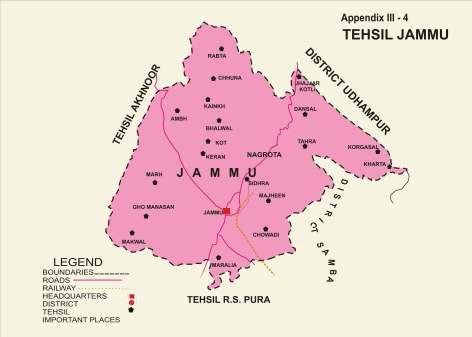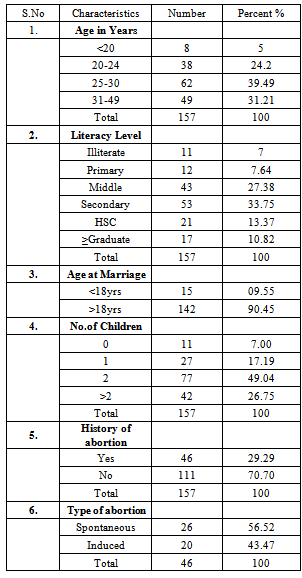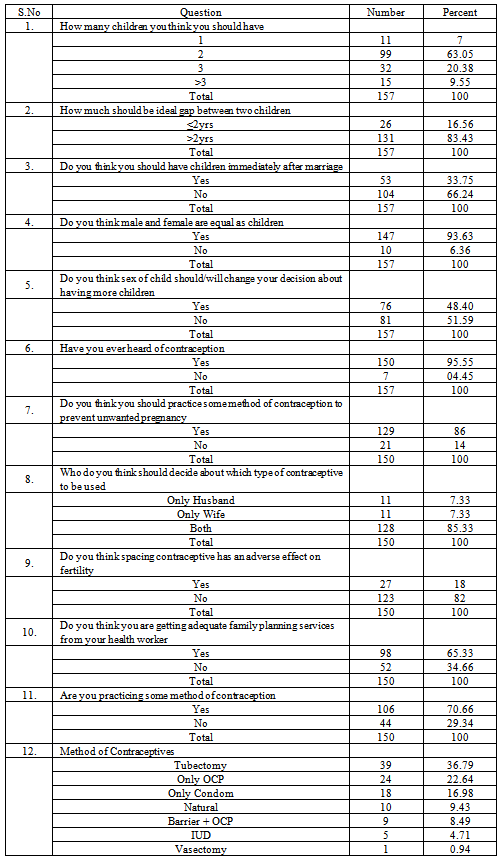-
Paper Information
- Next Paper
- Previous Paper
- Paper Submission
-
Journal Information
- About This Journal
- Editorial Board
- Current Issue
- Archive
- Author Guidelines
- Contact Us
Public Health Research
p-ISSN: 2167-7263 e-ISSN: 2167-7247
2013; 3(4): 92-97
doi:10.5923/j.phr.20130304.02
Contraceptive Prevalence, Attitude and Choice among Women of Reproductive Age Group in a Rural Area of Jammu, India
Rajiv Kumar Gupta, Aruna Kumari Verma, Tajali N Shora
PG Department of Community Medicine, GMC, Jammu, India
Correspondence to: Rajiv Kumar Gupta, PG Department of Community Medicine, GMC, Jammu, India.
| Email: |  |
Copyright © 2012 Scientific & Academic Publishing. All Rights Reserved.
Study Question: To find the prevalence of contraceptive use, unmet need and choice of contraceptive methods among reproductive age women in a rural area of Jammu district. Materials and Methods: A descriptive cross-sectional study was conducted in a randomly selected village in Miran Sahib zone of RS Pura block of Jammu district .House to house survey was conducted and in each house currently married females of reproductive age group were interviewed. A pre tested, pre-structured questionnaire was applied. The total population of village was 785. Overall 157 females were interviewed. Results: Majority of females (77/157) had two children while 42/157(26.75%) females had > 2children. 63.05% females opted for the two child norm. 83.43% of females opined that the ideal gap between two children should be >2yrs. 86% (129/157) wanted to adopt some method of contraception of which 70% (106/157) were using one or the other method of contraception hence unmet need of contraception came out to be16%. Tubectomy was the most preferred choice of family planning(36.79%).
Keywords: Contraception, Couple Protection Rate, Unmet Need
Cite this paper: Rajiv Kumar Gupta, Aruna Kumari Verma, Tajali N Shora, Contraceptive Prevalence, Attitude and Choice among Women of Reproductive Age Group in a Rural Area of Jammu, India, Public Health Research, Vol. 3 No. 4, 2013, pp. 92-97. doi: 10.5923/j.phr.20130304.02.
Article Outline
1. Introduction
- India has undergone fertility transition and important feature of this transition is the fact that contraceptive use has spread to even uneducated women[1] NFHS-III reports the prevalence of contraception as 56.3%[2]. The extent of acceptance of contraceptive methods and choice of contraceptive varies within societies .The factors for such varied picture operate at individual, family and community level with their roots in the socio-economic and cultural milieu of the Indian society[3]. It was envisaged in RCH-II to achieve a couple protection rate (CPR) of 53% as a short term strategic framework, while CPR of 65% should be achieved by 2012 to reach all India total fertility rate of 2.2[4].It has also been observed that addition of one new contraceptive method would increase CPR by 12%[2] and availability of contraceptives at the hour of need is the major issue in addressing the unmet need in contraception. This concept points gap between women’s reproductive intentions and their contraceptive behavior[5]. Unmet need rises as more women want to control their fertility but are not practicing any contraceptive method for one reason or the other and unmet need falls as more and more females use contraceptives[6].Despite launching National Family Planning Program in 1952 and with exponential growth of contraceptives in the last four decades, India still continues to face population explosion with last census reporting 1.21 billion population in the country[7]. About 68.8%of this population resides in rural areas of the country where pregnancies continue to be unplanned and unmet need for contraception remains high. It remains a major challenge for health workers to meet the contraceptive needs of the rural women where most of the women live and give birth. So a study in the currently married females was undertaken in a rural area of Jammu and Kashmir, India.
2. Aims and Objectives
- To find the prevalence of contraceptive use, unmet need and choice of contraceptive method among currently married women (15-49 years) in a rural area of Jammu district (J&K), India.
3. Methodology
- Jammu province is the winter capital of Jammu & Kashmir state of India and has 10 districts. Jammu district has a population of 1526406 as per 2011 census with 10 blocks for health delivery purposes. The study was conducted in RS Pura block of Jammu district, India which is a field practice area of Govt. Medical College, Jammu as shown in Figure 1. R.S Pura is a tehsil headquater bordering Pakistan with majority of people engaged in cultivation and following Hindu religion. Figure 2 shows various states and union territories of India. Using a simple random sampling technique, Miran Sahib Zone was selected out of eight zones in RS Pura block .In the next step, one village out of eight villages in the Miran Sahib zone was chosen to conduct the study using simple random sampling. A descriptive cross-sectional study was conducted in this randomly selected village. A team of undergraduate students was trained for data collection and collation .They conducted survey under the guidance of the authors. A house to house survey was done and in each house the currently married females of reproductive age group were interviewed after taking the informed consent from the interviewer. The total population of village was 785. Overall 157 females were interviewed. A pre tested, pre-structured questionnaire was prepared in the local language. Initially a pilot study was conducted which helped in testing and restructuring the instrument for actual study.
 | Figure 1. Map of Jammu District showing the Study area (R.S Pura) |
 | Figure 2. Map of India showing states and union territories |
4. Results
- In the study population, it was found that 39.49% (62/157) of females were in age group of 25-30 yrs. Regarding literacy status of the studied females , only 11/157 (7%) were illiterate and 33.75% (53/157) had studied up to secondary school certificate (10th standard) . Majority of females (77/157) had two children while 42/157 (26.75%) females had ≥ 2 children. An overwhelming 90.45% (142/157) were > 18 years of age at the time of marriage. (Table 1). 63.05% females agreed that two children norm would complete their family and only47/157 (29.93%) opined that they should have ≥3 children. A majority of the respondents i.e. 147/157 (93.63%) opined that the status of male and female child is equal. Sizeable number of females 76/157 (48.40%) thought that the sex of the child after first and second delivery had a bearing on the decision about the total number of children in the family. 131/157 (83.43%) of females were of opinion that the ideal gap between two children should be >2yrs.There was history of abortion in 46/157 (29.29%) of females of whom 43.47% had induced abortion.150 out of 157 females had heard of any contraceptive method, so further participation regarding choice of contraceptive and knowledge, attitude and practices was limited to them only. 86% (129/150) wanted to adopt some method of contraception of which 70% (106/150) were using one or the other method of contraception. 85.33% were of opinion that contraceptive choice should be jointly decided by couple.14.66% were of the opinion that the method of contraceptive should be decided only by husband or by wife, (Table 2). 18% of participants viewed that the spacing method of contraceptives would have an adverse effect on their future fertility.Accessibility to the family planning services is an important factor for acceptance of contraceptives as well as to meet the unmet need of contraception. 65.33% (98/150) of the females in the study population were satisfied by the family planning services provided by the health worker in their area.Permanent female sterilization was most preferred method of contraception as 39/150 women had already undergone tubectomy followed by oral contraceptive pill usage by 24/150 females. 18/150 women also reported condom use as a method of contraception.
|
|
5. Discussion
- The contraceptive prevalence in the present study was found to be 70.66%which was 14% higher than NFHS-3 data which reported a contraceptive prevalence rate of 56.3%. Worldwide contraceptive prevalence increased from 54.8% in 1990 to 63.6% in 2010[8]. The unmet need of contraception in the current study came out to be 16% while DLHS-3 showed it to be 21.3%[9]. Similarly, unmet need for contraception was reported to be 30.6%, 41.67% and 49.80% by Khokar A[10], SK Bhattacharya[11] and Puri A[12] respectively. The findings in the current study correspond to the global trend which shows that unmet need for family planning declined to 12.3% in 2010from 15.4% in 1990[8].62/157[39.49%]of the respondents in the current study belonged to 25-30 year age group which was contrary to the findings of Kansal A et al[13] who reported 24.42% females in the same age group in his study. The currently married females in 25-29 year age group comprises 21.78% in Jammu and Kashmir whereas this figure is 21.97% at the national level[14]. The mean age at effective marriage is the age at which consummation of marriage occurs, is almost stagnant and is hovering around 20 years between 2005 and 2009[14]. However in the rural areas substantial proportion of marriages continue to take place when the girl is around 16 years of age[2]. 93% (146/157) females in the current study were literate contrary to 54% at the national level[2]. It may be the reason for high contraceptive prevalence and low unmet need of contraception in our study. SK Bhattacharya[11] reported literacy rate of 56.70% in his study and a lower contraceptive prevalence of 45.83%. It was also supported by S. Bisoi et al[15] who reported that acceptance of contraception significantly higher among the literates (65.52%) than illiterates (55.8%).In another study, Harsha M Solanki et al[16] reported contraception prevalence of 59.2% in the met group who were mainly from 20-29year age group (46.6%), 46.8% were literate and 30.9% were from high socio – economic group as compared to the unmet need group in the study population. Another finding in the current study was that 73.23% of females had <2 living children and only 26.7% had ≥ 2 living children. The most probable reason for this was the high female literacy rate in the current study. NFHS – 3 data shows that total fertility rate declines from 3.55 amongst illiterate women to 1.8 in women who have completed ten years of school education[2]. In our study, 36.79%of females had chosen tubectomy as a contraceptive method followed by other methods of contraception like oral contraceptive pill and Condom. Bhasin SK[17], Kansal A[13],Ganai AM et al[18] and Puri A[12] also reported tubectomy as the most preferred choice in their studies. According to DLHS -3, the current use of contraceptive method was 47.1% using any modern method, out of which 34% used tubectony which almost conforms to the current study while only 5.9% used condoms whereas condom usage was 16.98% in our study. However, Oral Contraceptive Pills were more preferred than condom as a spacing method in our study. This may be because of more number of younger woman with higher awareness level due to their high literacy and easy accessibility to the family planning services in the study area. Another important feature of the current study was that 85.33%(128/150) of the women opined that contraceptive choice is a joint decision of the couple and hence contraceptive preference involves male’s equal participation. 86%(129/150) of the females in the study group had a positive attitude towards contraceptive usage and wanted to space their children, though current usage of contraceptive methods was 70.66% (106/150). 14.66% (28/150) opined that method of contraception should be decided by either of the spouse. 34.66% in the study were not receiving adequate family planning services. 18% of the total females in the study thought that spacing methods used by them would affect their future fertility and similar findings were reported by Sandra GG et al[19] in their study. This may be the obvious reason for non – acceptance of any contraceptive method in the rest of 29.34% (44/`150) of the females who reported non – utilization of any of the contraceptive methods.The study was limited to one village because of paucity of funds. The authors recommend to empower women for removal of sex bias, enhancing their educational status to graduation or more and improving the health services to local populace to improve contraceptive acceptance.
6. Conclusions
- In the current study, there is high contraceptive prevalence and low unmet need of contraception. The study shows that acceptance and contraceptive choice depends on joint decision of the couple and the female literacy has a positive impact on contraceptive practices .The need of the hour is continuous awareness regarding contraceptive methods, their usage and availability to the beneficiaries by our health workers in order to improve contraceptive prevalence rate.
 Abstract
Abstract Reference
Reference Full-Text PDF
Full-Text PDF Full-text HTML
Full-text HTML
